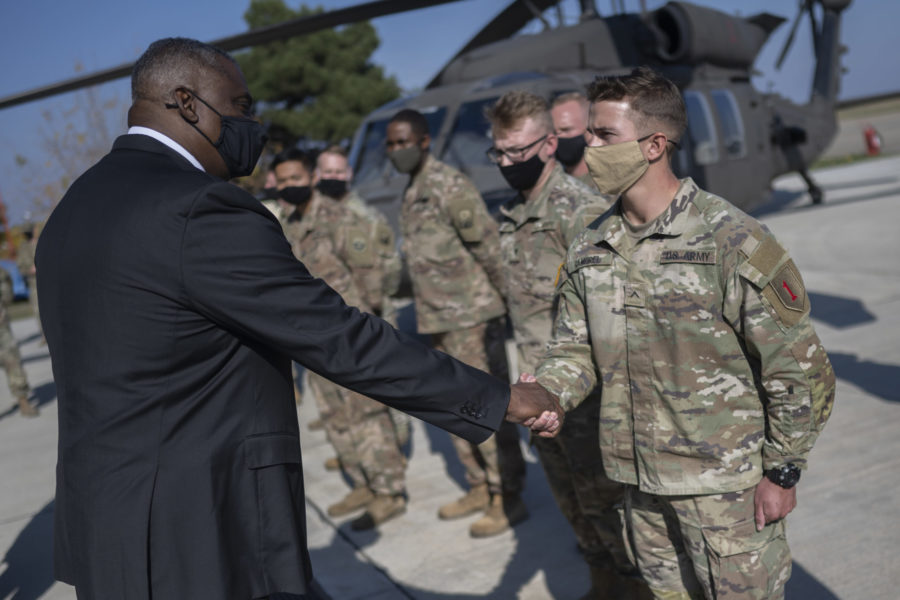Walking the flight line occupied by Blackhawk attack helicopters and American troops on rotation at the “MK” air base in Romania, Defense Secretary Lloyd J. Austin III highlighted the strategic value of one of NATO’s newest members Oct. 20 ahead of NATO defense ministerial meetings in Brussels Oct. 21-22.
“Romania is one of a handful of NATO allies that hosts a significant number of U.S. rotational forces,” Austin said after meeting Romanian Defense Minister Nicolae Ciuca.
“Security and stability of the Black Sea are in the U.S. national interest and are critical to the security of NATO’s Eastern Flank,” he added. “Russia’s destabilizing activities in and around the Black Sea reflect its ambitions to regain a dominant position in the region and to prevent the realization of a Europe that is whole, free, and at peace.”
Romanian security analyst Iulian Chifu told Air Force Magazine that Russia uses information warfare, electronic warfare, and the militarization of Crimea to threaten NATO’s Black Sea allies and partners. Russia also regularly buzzes, or flies low, over NATO commercial and military vessels in the Black Sea.
“We all understand it’s a matter of projection of force,” Chifu said of the growing Russian aggression.
“The problem is Crimea—which according to Russia is part of Russia, and they need to enforce that at some levels that are far overpassing the capacity even to attack anytime Romania, Bulgaria, and Turkey,” he said, naming the three NATO Black Sea partners.
Mihail Kogălniceanu Air Base near the Black Sea coast, known as “MK,” has received millions of dollars in European Deterrence Initiative investment and hosts several hundred American troops on continuous nine-month rotations. The air base is at the southeastern edge of NATO, just a few hundred miles from Russian-occupied Crimea.
In public comments, Austin said Romania plays a “key role” in U.S. freedom of access to the Black Sea.
The Romanian Defense Department has slated $135 million for investments at MK and training facilities at the nearby Capu Midia training area. MK has already been used as a waypoint for American deployments to Iraq and Afghanistan, where 27 Romanian troops died in combat over the 20-year conflict.
In part, Romania’s investments have been made to lure additional American troops, which act as a deterrent to Russia.
But Austin was coy about committing more American Soldiers and Airmen to Romania when asked by a journalist if the investments would lead to additional troops.
“Our posture in the region continues to present a credible threat against Russia and it enables NATO forces to operate more effectively should deterrence fail,” he said, citing the ongoing force posture review. “No announcements to make today.”
In June, Romania hosted several hundred American troops as part of the Defender-Europe exercises, including missile defense exercises at Capu Midia. Romania’s 2 percent GDP spending on defense has helped the former communist dictatorship and Soviet ally emerge from behind the Iron Curtain and modernize its defense equipment with NATO interoperable hardware and American technology.
Romania hosts Phase 2 of NATO’s Ballistic Missile Defense system in Deveselu with the only operational Aegis Ashore system, active since 2016. Phase 3 will include an Aegis Ashore system in Redzikowo, Poland. Phase 1 of the missile defense program uses regional American naval assets with Aegis missile defense systems.
Preparing for the NATO Summit
Austin joined NATO Secretary General Jens Stoltenberg and defense ministers from the alliance Oct. 21 for two days of meetings that begin NATO’s strategic shift in the wake of the Afghanistan withdrawal.
While the American Defense Secretary was not scheduled to make public remarks until the meetings’ conclusion, Stoltenberg previewed the topics of discussion in a press conference Oct. 20, with a focus on NATO’s turn to technology.
“Future conflicts will be fought not just with bullets and bombs, but also with bytes and big data,” he said. “We see authoritarian regimes racing to develop new technologies, from artificial intelligence to autonomous systems.”
Stoltenberg said this week allies will kick off a $1.16 billion NATO Innovation Fund to develop dual-use emerging and disruptive technologies. NATO will also establish its first artificial intelligence strategy to incorporate data analysis, imagery, and cyber defense.
Stoltenberg also touched on historically low relations with Russia, which closed its mission to NATO this week and the NATO offices in Moscow following the expulsion of eight Russian intelligence officers from Brussels.
He also addressed the threat posed by Russia’s development of nuclear-capable and hypersonic missiles.
“These missiles pose a real threat to security in the Euro-Atlantic area,” he said. “We will not mirror Russia’s actions, but we will maintain strong deterrence and defense.”
In comments from Bucharest the same day, Austin predicted Afghanistan would be a topic of discussion.
“As you would imagine, no doubt, we will talk about NATO’s role post-Afghanistan and some of the lessons learned from Afghanistan,” Austin said.
Stoltenberg promised a “thorough and clear-eyed assessment” of the alliance’s 20-year involvement in the country, which began as a narrow counterterrorism mission and expanded to an “ambitious nation building effort.” Included will be an assessment of the risks of engaging in “big missions and operations outside NATO territory.”
Stoltenberg also expressed confidence that American commitment to NATO had returned after reluctance during the Trump era.
“What we see now is the U.S. administration which is strongly committed to rebuilding, strengthening alliances. And in particular strengthening the trans-Atlantic bond between Europe and North America,” he said.
Asked if NATO at its June 2022 summit in Madrid would give a strong signal to aspiring members, such as Georgia and Ukraine, where Austin visited prior to arriving in Brussels, Stoltenberg demurred.
“We will continue to work on how we can further strengthen the partnership with Georgia, how we can make sure that we both provide political and practical support,” he said.
